#St. Vincent Indians
Explore tagged Tumblr posts
Text
Nailah Blackman at St. Vincent Carnival
#caribbean#caribbean culture#caribbean women#caribbean woman#caribbean gyal#playin mas#mas#masqueraders#Oxygen Mas#st. vincent#St. Vincent Carnival#St. Vincent Carnival 2023#carnival#carnival 2023#wine#dance#on the road#melanin#west indies#west indian#small island#island life#island gyal#trinidadian#trinidad#black women#black#soca#black woman#black women are beautiful
39 notes
·
View notes
Text




4 notes
·
View notes
Text
The [...] British quest for Tahitian breadfruit and the subsequent mutiny on the Bounty have produced a remarkable narrative legacy [...]. William Bligh’s first attempt to transport the Tahitian breadfruit [from the South Pacific] to the Caribbean slave colonies in 1789 resulted in a well-known mutiny orchestrated by his first mate [...]. [T]he British government [...] successfully transplanted the tree to their slave colonies four years later. [...] [There was a] colonial mania for [...] the breadfruit, [...] [marked by] the British determination to transplant over three thousand of these Tahitian food trees to the Caribbean plantations to "feed the slaves." [...]
Tracing the routes of the breadfruit from the Pacific to the Caribbean, [...] [shows] an effort initiated, coordinated, and financially compensated by Caribbean slave owners [...]. [During] decades worth of lobbying from the West Indian planters for this specific starchy fruit [...] planters [wanted] to avert a growing critique of slavery through a "benevolent" and "humanitarian" use of colonial science [...]. The era of the breadfruit’s transplantation was marked by a number of revolutions in agriculture (the sugar revolution), ideology (the humanitarian revolution), and anticolonialism (the [...] Haitian revolutions) [as well as the American and French revolutions]. [...] By the end of Joseph Banks’ tenure [as a botanist and de facto leader] at the Kew Botanical Gardens [royal gardens in London] (1821), he had personally supervised the introduction of over 7,000 new food and economic plants. [...] Banks produced an idyllic image of the breadfruit [...] [when he had personally visited Tahiti while part of Captain Cook's earlier voyage] in 1769 [...].
---
[I]n the wake of multiple revolutions [...], [breadfruit] was also seen as a panacea for a Caribbean plantation context in which slave, maroon, and indigenous insurrections and revolts in St Vincent and Jamaica were creating considerable anxiety for British planters. [...]
Interestingly, the two islands that were characterized by ongoing revolt were repeatedly solicited as the primary sites of the royal botanical gardens [...]. In 1772, when St Vincentian planters first started lobbying Joseph Banks for the breadfruit, the British militia was engaged in lengthy battle with the island’s Caribs. [...] By 1776, months after one of the largest slave revolts recorded in Jamaica, the Royal Society [administered by Joseph Banks, its president] offered a bounty of 50 pounds sterling to anyone who would transfer the breadfruit to the West Indies. [...] [A]nd planters wrote fearfully that if they were not able to supply food, the slaves would “cut their throats.” It’s widely documented that of all the plantation Americas, Jamaica experienced the most extensive slave revolts [...]. An extensive militia had to be imported and the ports were closed. [...]
By seeking to maintain the plantation hierarchy by importing one tree for the diet of slaves, Caribbean planters sought to delay the swelling tide of revolution that would transform Saint Domingue [Haiti] in the next few years. Like the Royal Society of Science and Arts of Cap François on the eve the Haitian revolution, colonists mistakenly felt they could solve the “political equation of the revolution […] with rational, scientific inquiry.” [...]
---
When the trees arrived in Jamaica in 1793, the local paper reported almost gleefully that “in less than 20 years, the chief article of sustenance for our negroes will be entirely changed.” […] One the one hand, the transplantation of breadfruit represented the planters’ attempt to adopt a “humanitarian” defense against the growing tide of abolitionist and slave revolt. In an age of revolution, [they wanted to appear] to provide bread (and “bread kind”) [...]. This was a point not to be missed by the coordinator of the transplantation, Sir Joseph Banks. In a letter written while the Bounty was being fitted for its initial journey, he summarized how the empire would benefit from new circuits of botanical exchange:
Ceres was deified for introducing wheat among a barbarous people. Surely, then, the natives of the two Great Continents, who, in the prosecution of this excellent work, will mutually receive from each other numerous products of the earth as valuable as wheat, will look up with veneration the monarch […] & the minister who carried into execution, a plan [of such] benefits.
Like giving bread to the poor, Banks articulated this intertropical trade in terms of “exalted benevolence,” an opportunity to facilitate exchange between the peoples of the global south that placed them in subservience to a deified colonial center of global power. […]
---
Bligh had no direct participation in the [slave] trade, but his uncle, Duncan Campbell (who helped commission the breadfruit journey), was a Jamaican plantation owner and had employed Bligh on multiple merchant ships in the Caribbean. Campbell was also deeply involved, with Joseph Banks, in transporting British convicts to the colonies of Australia. In fact Banks’ original plan for the breadfruit voyage was to drop off convicts in (the significantly named) Botany Bay, and then proceed to Tahiti for the breadfruit. Campbell owned a series of politically untenable prison hulks on the Thames which he emptied by shipping his human chattel to the Pacific. Banks helped coordinate these early settlements [...] to encourage white Australian domesticization.
The commodification and rationalist dispersal of plants and human convicts, slaves, the impoverished, women, and other unwilling participants in global transplantation is a rarely told narrative root of colonial “Bounty.”
---
All text above: Elizabeth DeLoughrey. “Globalizing the Routes of Breadfruit and Other Bounties”. Journal of Colonialism and Colonial History Volume 8, Number 3, Winter 2007. [Bold emphasis and some paragraph breaks/contractions added by me. Presented here for commentary, teaching, criticism purposes.]
#incredible story of ecology violence hubris landscape cruelty interconnectivity and rebellion#ecology#multispecies#abolition#colonial#imperial#landscape#caribbean#indigenous
85 notes
·
View notes
Text
We, Black Curatorial, Kwanda, Twossaints, Black Eats London & West India Cinema Corporation have come together to fundraise for people affected by Hurricane Beryl across the West Indies. As West Indian people it is imperative that we support each other and ourselves in the building back of our communities, this is a duty. Hurricane Beryl has devastated hundreds of communities in the West Indies. This is not a freak storm, this is a direct impact of climate crisis in the region - fuelled and sustained by overconsumption and emissions in the Global North. The ocean waters are 4 degrees warmer than expected at this time of year, this has directly affected the speed and ferocity of the hurricane at the beginning of this year's hurricane season. To understand what the importance of AMOC (Atlantic Meridional Overturning Circulation) is for Hurricane season in the Caribbean and globally please watch this video. The impact of this hurricane is very much being felt, "90% of homes on Union Island had been destroyed", according to Prime Minister Ralph Gonsalves. We’re fundraising for people and charities across Barbados, St Vincent & the Grenadines, Grenada and those affected across the region. The money raised will go towards helping local fishermen in Barbados to buy new boats, support roofing and housing materials for people in Carriacou, Union and Grenada and well as St Vincent to rebuild their livelihoods and homes. We are working collectively to disseminate these funds across the region ensuring they reach grassroots communities and people directly. The Hurricane is now a category 5 and on its way to Jamaica. We urge everyone to pray for its weakening and for the people currently effected by Beryl's peril. Please continue to share and donate to those affected! If you have any questions please email us.
WHERE ARE THE DONATIONS GOING?
This fund exists to go directly to grassroots organisations providing support for those across the following countries: Barbados St Vincent & the Grenadines Carriacou Petite Martinique Union Grenada Jamaica
HOW WILL THEY BE PROCESSED AND ADMINISTERED?
We are working with Kwanda to help disseminate the funds to the existing groups they work with in the affected countries. Black Curatorial work across Barbados and Jamaica administering funds for creatives via the Fly Me Out Fund our process of sending money via transfer is already set up to support and facilitate this fund's dissemination.
WHO'S INVOLVED?
Black Curatorial Kwanda West India Cinema Corporation Twossaints Black Eats London
#west indies#caribbean#hurricane beryl#barbados#st vincent and the grenadines#petite martinique#carriacou#grenada#jamaica#union island#hurricane relief#mutual aid#gofundme#donate if you can#donation boost#disaster recovery
35 notes
·
View notes
Note
original anon here tysm for the recs ! if the marxist frameworks was too limiting im also completely fine w general postcolonial botany readings on the topic :0
A Spiteful Campaign: Agriculture, Forests, and Administering the Environment in Imperial Singapore and Malaya (2022). Barnard, Timothy P. & Joanna W. C. Lee. Environmental History Volume: 27 Issue: 3 Pages: 467-490. DOI: 10.1086/719685
Planting Empire, Cultivating Subjects: British Malaya, 1786–1941 (2018). Lynn Hollen Lees
The Plantation Paradigm: Colonial Agronomy, African Farmers, and the Global Cocoa Boom, 1870s--1940s (2014). Ross, Corey. Journal of Global History Volume: 9 Issue: 1 Pages: 49-71. DOI: 10.1017/S1740022813000491
Cultivating “Care”: Colonial Botany and the Moral Lives of Oil Palm at the Twentieth Century’s Turn (2022). Alice Rudge. Comparative Studies in Society and History Volume: 64 Issue: 4 Pages: 878-909. DOI: 10.1017/S0010417522000354
Pacific Forests: A History of Resource Control and Contest in Solomon Islands, c. 1800-1997 (2000). Bennett, Judith A.
Thomas Potts of Canterbury: Colonist and Conservationist (2020). Star, Paul
Colonialism and Green Science: History of Colonial Scientific Forestry in South India, 1820--1920 (2012). Kumar, V. M. Ravi. Indian Journal of History of Science Volume: 47 Issue 2 Pages: 241-259
Plantation Botany: Slavery and the Infrastructure of Government Science in the St. Vincent Botanic Garden, 1765–1820 (2021). Williams, J'Nese. Berichte zur Wissenschaftsgeschichte Volume: 44 Issue: 2 Pages: 137-158. DOI: 10.1002/bewi.202100011
Angel in the House, Angel in the Scientific Empire: Women and Colonial Botany During the Eighteenth and Nineteenth Centuries (2020). Hong, Jiang. Notes and Records: The Royal Society Journal of the History of Science Volume: 75 Issue: 3 Pages: 415-438. DOI: 10.1098/rsnr.2020.0046
From Ethnobotany to Emancipation: Slaves, Plant Knowledge, and Gardens on Eighteenth-Century Isle de France (2019). Brixius, Dorit. History of Science Volume: 58 Issue: 1 Pages: 51-75. DOI: 10.1177/0073275319835431
African Oil Palms, Colonial Socioecological Transformation and the Making of an Afro-Brazilian Landscape in Bahia, Brazil (2015). Watkins, Case. Environment and History Volume: 21 Issue: 1 Pages: 13-42. DOI: 10.3197/096734015X14183179969700
The East India Company and the Natural World (2015). Ed. Damodaran, Vinita; Winterbottom, Anna; Lester, Alan
Colonising Plants in Bihar (1760-1950): Tobacco Betwixt Indigo and Sugarcane (2014). Kerkhoff, Kathinka Sinha
Science in the Service of Colonial Agro-Industrialism: The Case of Cinchona Cultivation in the Dutch and British East Indies, 1852--1900 (2014). Hoogte, Arjo Roersch van der & Pieters, Toine. Studies in History and Philosophy of Science Part C: Studies in History and Philosophy of Biological and Biomedical Sciences Volume: 47 Issue: Part A Pages: 12-22
Trading Nature: Tahitians, Europeans, and Ecological Exchange (2010). Newell, Jennifer
The Colonial Machine: French Science and Overseas Expansion in the Old Regime (2011). McClellan, James E. & Regourd, François
Colonial Botany: Science, Commerce, and Politics in the Early Modern World (2005). Ed. Schiebinger, Londa L. & Swan, Claudia
Plants and Empire: Colonial Bioprospecting in the Atlantic World (2004). Schiebinger, Londa L.
92 notes
·
View notes
Text
i was tagged by lovely @jeeu to pick one song per letter of my url :-) thanku jee this was fun ❤️🔥
h - how to love - yukika
y - you’re so fine - cnblue
p - pain for fun - willow, st. vincent
e - expired! - sion
r - runner’s high - tabber
s - slumlord - neon indian
t - tic toc tic toc - sumin, slom
e - entertainer - zayn
l - life size - mahalia
l - lithonia - childish gambino
a - all my girls like to fight - hope tala
r - rockin’ - the weekend
tagging @theboytatu @notyuta @papercutsmp3 @biwooyoung @hwajoongie @sheawolfmp3 @sodrippy @neonsbian @28reas0ns @cbxenjoyer <- now that your url is no longer 1000 characters long <3 AND THE GIRL READING THIS‼️
#forgot half of these songs exist. my liked songs playlist is an abyss#tag games#oh rockin’s a banger i can’t believe i forgot about you
12 notes
·
View notes
Text

"In The Black Carib Wars, Christopher Taylor offers the most thoroughly researched history of the struggle of the Garifuna people to preserve their freedom on the island of St. Vincent.
Today, thousands of Garifuna people live in Honduras, Belize, Guatemala, Nicaragua and the United States, preserving their unique culture and speaking a language that directly descends from that spoken in the Caribbean at the time of Columbus. All trace their origins back to St. Vincent where their ancestors were native Carib Indians and shipwrecked or runaway West African slaves―hence the name by which they were known to French and British colonialists: Black Caribs
In the 1600s they encountered Europeans as adversaries and allies. But from the early 1700s, white people, particularly the French, began to settle on St. Vincent. The treaty of Paris in 1763 handed the island to the British who wanted the Black Caribs' land to grow sugar. Conflict was inevitable, and in a series of bloody wars punctuated by uneasy peace the Black Caribs took on the might of the British Empire. Over decades leaders such as Tourouya, Bigot, and Chatoyer organized the resistance of a society which had no central authority but united against the external threat. Finally, abandoned by their French allies, they were defeated, and the survivors deported to Central America in 1797."
#st vincent#black community#original photographers#black people#artwork#black art#black history#black culture#graphic design#black power#black family#black woman#black man#black panther#black#black music#black history month#black tumblr#black is black#black men#slavery#black africans#africa art#africa#african
17 notes
·
View notes
Text
tue … wednesday,
gif warning on this one!
i was gonna post this last night but apparently i am now the type of person who gets extreme digestive distress from indian food :-( so i was too distracted by my agonies. much better today, and i feel like i had a worse reaction a few weeks ago from indian food, so maybe it's something that will get better with time like everything else ...
listening: so my brother spontaneously bought us tickets to see st vincent in [redacted] while we're on vacation...i haven't listened to her in ages but i was like sure why not...her new album dropped on the 26th and it's SO good. i'm kinda obsessed and very excited to see her live now. it's a good album. listen to it.
listened/watched the wtyp on five over ones, and started the more recent one on the camp fire.
reading: continuing 'how to read poetry like a professor'. yum. poetry.
watching: once again, dunmeshi (my boyf keeps asking "when is best girl showing up" (izutsumi) and i finally was able to be like "i think next episode"), more asobi asobase. insane show. the voice actors are masters of their craft, truly. good lord.
playing: fallow.
making: some stuff came out of the kiln that i actually like! the cave painting mugs!!! i made One fatal error - i put a 'satin' topper over the outside assuming it would be matte. it. kinda isn't? kinda is? made these weird "jizzy" (instructor's words, not mine, lol) streaks. thankfully it isn't too noticeable and they came out really good otherwise. the hardest part has been photographing them, the designs go all the way around and choosing a favorite is so hard...i made a gif to try and capture it all lol, and i really love the little handprints on the handles. these will go in their own post in the next few days so i can tag the inspiring artist :)

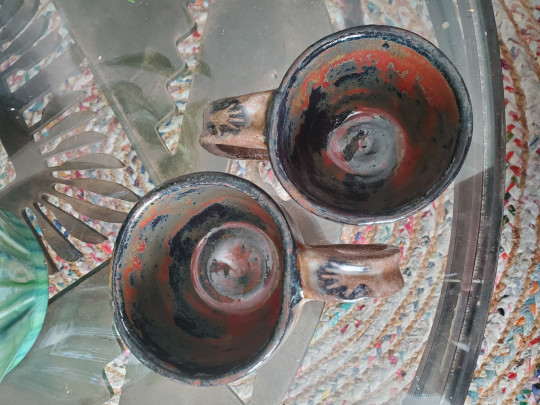
i also threw some new ones to make more! i do think in the future i will be handbuilding them though. i just really don't like throwing red clay for some reason. maybe i just need to practice more i dunno. i've since trimmed and put handles on these but i forgor to take a photo.
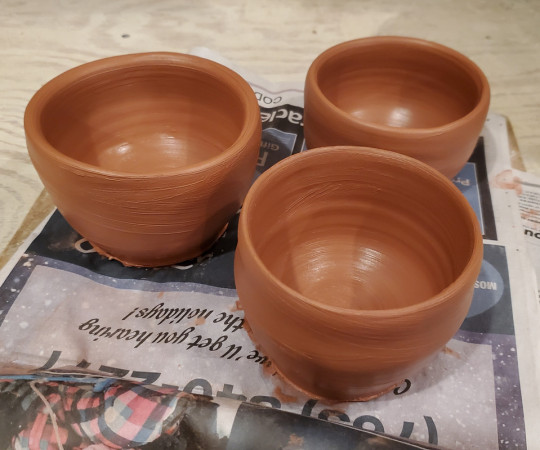
citrus juicer! it works!! it came out a little more Orange than i anticipated, the only downsides are manually scooping out the seeds, and also that it can kinda only handle one fruit at a time, but man, whatever, it's so cute.
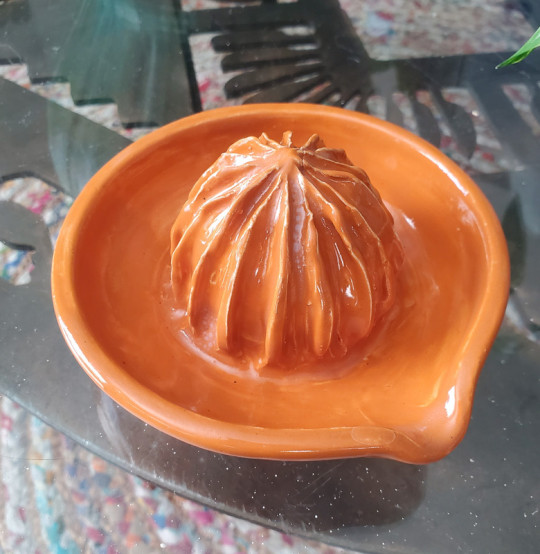
mug/teacup that i tried a new underglaze technique on, where i put the flowers on the greenware and then use liquid latex to cover them to just slather the thing in the bg color: works well, i did this for the mug from last week too! my mistake with this one was putting that same jizzy satin overglaze on the flowers and it made them weird and blurry. it's cute otherwise though.

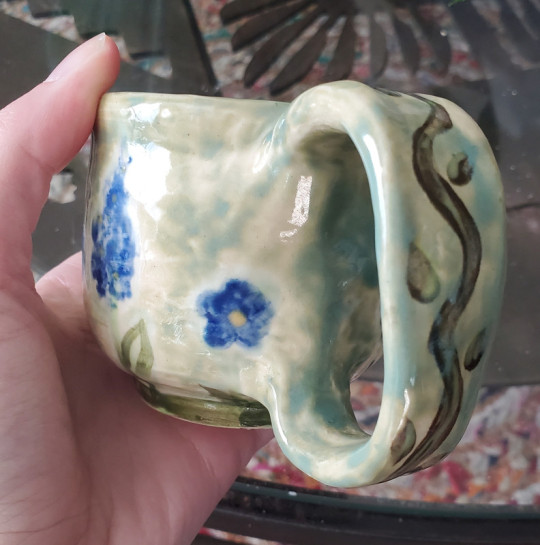
some stuff going in the kiln for bisque: fun texture bowl and a little trinket dish that i underglazed some cherry blossom trees on, inspired by something a friend in class did!
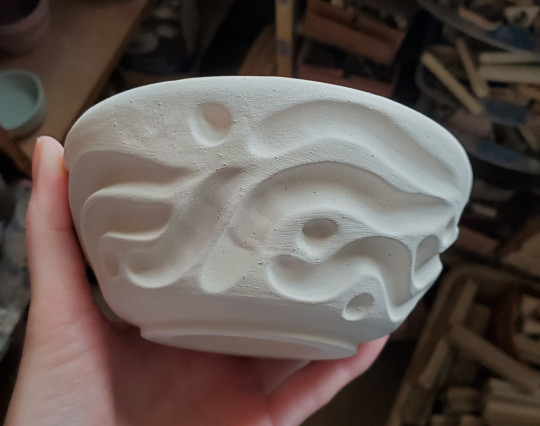
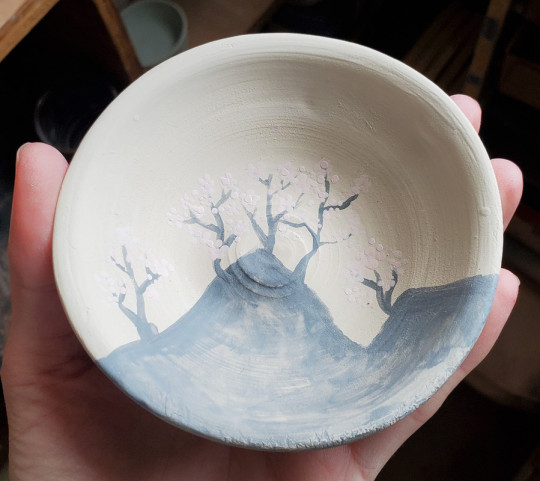
in terms of new things, today is actually the last day of class for me til i get back in july, so i will be trimming a pot and plate that i made last week but will otherwise just work on things i already have! the goal is just to leave things in a place where no extra clay work needs to be done; things can be left as greenware til i get back.

i also made some little watercolor palettes! for some reason the last one i made i didn't carve out material, i just sort of pressed in, and this made the whole thing a little wonky, so i'm hoping these will lay flat because i carved material out

eating: nothing of crazy note. made deb smittenkitchen's soy glazed chicken again because it whips ass.
misc: wough...fucked up day......butter chicken for dinner knocked me for a major loop last night and i wasn't able to sleep til like 1:30am from the Agonies, woke up to feed the cats and then went right back to bed...didn't get up til noon...but now i feel loads better so i might try to do some light exercise this afternoon before pottery, otherwise sleeping tonight is gonna be a nightmare lol. the goal for the afternoon is to submit my last thing for classes (takehome exam, it's not bad i just have to finish it up, and then i officially finished my masters degree (!!!)) and then do a little more for my meeting tomorrow morning. this time next week my brother will be here with me, and that following weekend we drive home together, so everything is about to happen very fast! i'm not gonna be home for as long this summer, and won't just be rotting in my room the whole time, so hopefully things will go much more smoothly mental health wise. fingers crossed! things are looking up! :)
6 notes
·
View notes
Note
could i please have a paper rings for an f1 driver!
I’m 18, studying classics, and love history. I speak english, spanish, and little bits of cantonese and hindi. I’m indian and chinese and american but grew up in singapore. I’m a virgo sun, aires moon, and scorpio rising. I love fiona apple, taylor swift, hozier, and st vincent. My big dream is to be an academic and own a vineyard and just live in the countryside.
I love your work so much!!!
DANIEL RICCIARDO
def love listening to you talk about history
obsessed with the way you speak spanish
trys to learn as much as he can about your costumes and culture
def check if your zodiacs were compatible and one point or another
plays your fav music in the car
and well you dream is daniels reality
both of you live on a vineyard/farm in the country side being all cute and shit
7 notes
·
View notes
Text
basic info dumping about the lads
!not set in stone!
JUNIPER PASSERINE:
lesbian
she/her
greek/hispanic
adhd, asperger's syndrome, recovering anorexic
house wren
june 2nd, 2006 (gemini)
ISTP-A
phoebe (mother) + carmelo (father)
cape suzette
spunky, brutally honest, assertive
pink
into engineering
inspiration: nikki (camp camp)
VA: elizabeth maxwell
XIMENA AVIANTA:
bisexual demisexual demigirl
she/they
hispanic
anxiety
robin
may 14th, 2006 (taurus)
ISFJ-T
harper (mother) + alonso (father)
st. canard
quiet, strong, smart
orange
into chemistry
inspiration: varian/catalina (tangled: the series)
VA: ruby jay
OZUL "OZZY SWAN" FLOCKSON:
gay
he/him
black (dark-skinned)
anxiety, depression
black swan
october 7th, 2006 (libra)
ENTP-T
esther (mother) + major (father), rhys (step-father)
faith (younger half-sister by 15 years)
st. canard
laidback, loyal, sarcastic
blue
into pyromancy
inspiration: louis (telltale: the walking dead)
VA: vincent tong
KAMARA "DOTTIE ANGELS" CHAMNANCAT:
omnisexual aromantic
she/her
thai/ethiopian
depression, cptsd
ocicat
november 30th, 2005 (sagittarius)
chariya (mother) + negasi (father)
kimora (younger sister by 9 years)
st. canard
tough, short tempered, rude
black
into therapy
inspiration: cassandra (tangled the series)
VA: eden espinosa
ZEKE "HUNTER" GUNDOG:
pansexual asexual
he/him
irish
cptsd
irish setter
february 13th, 2006 (aquarius)
roisin † (mother) + finn † (father), noelle (adoptive mother) + blanca (adoptive mother)
conor † (older brother by 6 years)
duckburg
friendly, strong, trusting
white
into history
inspiration: glenn rhee (the walking dead)/tadashi hamada (big hero 6)
VA: cameron boyce
WHITTANY LOP:
pansexual
she/her
black (light-skinned)/danish
adhd, anxiety
black lop rabbit
september 23rd, 2006 (libra)
winterva (mother) + leonard (father)
giselle (older sister by 5 years), cashmere and ricky (older sister and brother by 4 years), myrene (older sister by 2 years), jocelyn (younger sister by 3 years), shawn (younger brother by 8 years), malina (younger sister by 11 years)
cape suzette
chipper, condescending, fearful
purple
into art
inspiration: pinkie pie (my little pony)
VA: haley tju
EVERETT MUSTELIDANTE:
bisexual
he/him
indian/german
anxiety, depression
sable ferret
january 24th, 2005 (aquarius)
edith (mother) + emerson (father)
cape suzette
independant, distant, nerdy
red
into music/film
inspiration: sakutaro morishige (corpse party)
VA: jeremy jordan
SYLVIA HONEYBERG:
straight/greysexual
she/her
swedish/white/italian
anxiety, bulimia
red-legged honeycreeper
june 25th, 2005 (cancer)
seek (mother) + nolan (father)
duckburg
preppy, insecure, adventurer
brown
into fashion
inspiration: porsha crystal (sing 2)
VA: abigail zoe lewis
MARSHALL "MARSHMALLOW" SNOWSHOE:
gay demiromantic demiboy
he/they
white/russian
adhd
canadian lynx
august 15th, 2007 (leo)
fanya (mother) + austin † (father)
masha (younger sister by 4 years)
st. canard
outgoing, flirt, sweetheart
yellow
into mixology
inspiration: william clockwell (invincible)
VA: bryce papenbrook
HAE-WON "ASH" FLIWIG:
nonbinary aroace
they/them
korean
osteoporosis, anxiety
yellow canary
august 31st, 2005 (virgo)
soo-ah (mother) + du-ho (father)
duckburg
sarcastic, reserved, logical
sea green
into writing
inspiration: violet (telltale: the walking dead)
VA: colleen o’shaughnessey
EMALINE "KIWI" PURRBORNE:
bisexual
she/her
native american
epilepsy, lupus
bombay cat
july 17th, 2005 (cancer)
janese (mother) + king (father)
mariana (younger sister by 4 years), olivia (younger sister by 6 years)
st. canard
goofy, selfless, optimistic
light blue
into baking
inspiration: sayori (doki doki literature club)
VA: mae whitman
ADEN FANG:
demiromantic, demisexual
he/him
japanese/korean
cptsd
dhole
february 27th, 2004 (pisces)
cho (mother) + hiroshi (father)
cape suzette
distant, distrusting, loyal
grey
into criminalistics
inspiration: bigby wolf (telltale: the wolf among us)
VA: adam harrington
SAIGE "NIX" RODENTIA:
pansexual
she/her
portuegese/egyptian
cptsd
gundi
february 1st, 2005 (aquarius)
leonor † (mother) + rodrigo (father)
protective, tired, edgy
dark purple
into jewelry
inspiration: kenny/lee everett/clementine (the walking dead)
VA: lauren ash
DEAN RODENTIA:
straight
he/him
portuegese/egyptian/white
cptsd, depression, anxiety, asperger's syndrome
capybara
october 20th, 2006 (libra)
nour † (mother) + seth † (father)
lackadaisical, smart, strong-willed
pastel orange
into astronomy
inspiration: dipper pines (gravity falls)
VA: michael sinterniklaas
VIVIAN "VIV" PYROAR:
lesbian
she/her
black/white
social anxiety, adhd
lioness
november 29th, 2004 (sagittarius)
frances (mother) + timber (father)
childish, witty, artsy
magenta
into culinary
inspiration: rapunzel (tangled)
VA: erica lindbeck
#ozzy swan#juniper passerine#ximena avianta#whittany lop#everett mustelidante#hunter gundog#dottie angels#vivian pyroar#kiwi purrborne#marshall snowshoe#sylvia honeyberg#nix rodentia#dean rodentia#ash fliwig#aden fang#dt emeralds#dt opals#dt emerald opals
7 notes
·
View notes
Text
#caribbean#caribbean culture#caribbean women#caribbean gyal#caribbean woman#caribbean men#caribbean man#st. vincent#st. Vincent Carnival#st. vincent carnival 2023#carnival#carnival 2023#vincy mas#mardi gras#west indies#west indian#island gyal#wine#dance#black#black women#beautiful#beautiful woman#beautiful women#mas#masqueraders#playing mas#black is beautiful#black woman#Spotify
31 notes
·
View notes
Text

In April 2024, scientists from the Natural History Museum of Jamaica and The University of the West Indies, Mona Campus accepted a very rare and historic specimen: a 16-inch lizard called the Jamaican giant galliwasp (Celestus occiduus). It had previously been stored in the Hunterian museum at the University of Glasgow in Scotland. “‘Celeste’ is home!” announced one Jamaican news outlet [...]. Celeste was collected in the 1850s and represents a species that was endemic to Jamaica but is now classified as critically endangered and possibly extinct. Scientists in Jamaica, who have never seen or handled one of these lizards, are elated [...]. As scholars of Jamaican landscape histories who are interested in environmental justice, we believe this repatriation illustrates important truths about colonialism and its legacies.
Celeste’s 170-year residence in a Scottish university collection speaks to uncomfortable connections between colonialism and natural history.
---
[O]fficials, physicians, naturalists and amateurs from Europe traveled across the colonized world, collecting local plants and animals [...]. Many objects they brought back [...] are housed today in European libraries and museums. [...] “The Civil and Natural History of Jamaica,” by Patrick Browne, published in 1755, was the first text in the English language to use the system of classifying plants developed by Carl Linnaeus. The book shows how major advancements in natural history, botany and biology relied on field work conducted far beyond metropolitan Europe. [...] Exploration and collecting specimens often relied on the knowledge and labor of enslaved persons who acted as field assistants and guides – but the historical record has little to say about their roles. Today, organizations such as Kew Royal Botanical Gardens in England and the New York Botanical Garden continue to rely on the knowledge and collections derived from colonial-era tropical botanical gardens in places like the Caribbean islands of St. Vincent and Jamaica.
In Jamaica, there was a direct relationship between geological exploration and the plantation system. The first geological surveys of Jamaica were conducted by naturalist Sir Henry De la Beche, the son of a Jamaican plantation owner and first director of the Geological Survey of Great Britain.
British physician and naturalist Sir Hans Sloane’s extensive holdings of books, manuscripts and specimens became the founding collection of the British Museum. [...] His collections include more than 1,500 plant specimens from Jamaica, which he acquired there from 1687 to 1689. After England gained formal possession of Jamaica in 1670, it established monoculture production of sugarcane across the island. Extensive land clearance, damage to local ecosystems [...] exacted a heavy toll. Some of the plant and animal specimens that collectors extracted and exported abroad may be the only ones that exist today.
---
Colonizers also introduced harmful species, such as the Indian gray mongoose (H. edwardsii), which was brought to Jamaica to prey on rats in plantation sugarcane fields. [...] The Indian grey mongoose quickly became a major threat to numerous species, including the Jamaican giant galliwasp.
It remains a key adversary today in the struggle to stabilize the population of the critically endangered Jamaican iguana. [...]
The Jamaican giant galliwasp’s classification as possibly extinct in the wild reflects optimism from the almost unbelievable rediscovery of the Jamaican iguana (Cyclura collei). Prior to 1990, this species was presumed extinct, but then scientists discovered a remnant population in the island’s Hellshire Hills.
---
All text above by: Alex A. Houghton and Thera Edwards. "Returning a 170-year-old preserved lizard to Jamaica is a step toward redressing colonial harms". The Conversation. 3 June 2024. At: theconversation.com/returning-a-170-year-old-preserved-lizard-to-jamaica-is-a-step-toward-redressing-colonial-harms-229339 [Bold emphasis and some paragraph breaks/contractions added by me. Presented here for commentary, teaching, criticism purposes.] Image and caption are shown unaltered as they originally appear published with the article. Image is CC BY-ND 4.0, available at biodiversitylibrary.org/page/188786.
12 notes
·
View notes
Note
Reading background songs 🫶🏻
I mostly listen to instrumental stuff if I want background music (the ultimate is listening to the film score if there's an adaptation of the book you're reading) but if I do listen to regular music it's always chill stuff like
dust to dust - the civil wars
light years - the national
the bells - from indian lakes
rosyln - bon iver & st vincent
don't you worry - oh wonder
3 notes
·
View notes
Text
Happy 248th Birthday to the US Navy!
The bravery of four Catholic chaplains in the line of duty has been recognized by US Navy vessels named in their honor:
Father Aloysius H. Schmitt and the USS Schmitt

Aloysius H. Schmitt was born in St. Lucas,Iowa on December 4, 1909, and was appointed acting chaplain with the rank of Lieutenant (Junior Grade) on June 28, 1939. Serving on his first sea tour, he was hearing confessions on board the battleship USS Oklahoma when the Japanese attacked Pearl Harbor on December 7, 1941. When the ship capsized, he was entrapped along with several other members of the crew in a compartment where only a small porthole provided a means of escape. He assisted others through the porthole, giving up his own chance to escape, so that more men might be rescued. He received the Navy and Marine Corps Medal posthumously for his courage and self-sacrifice. St. Francis Xavier Chapel, erected at Camp Lejeune in 1942, was dedicated in his memory.
The destroyer escort USS SCHMITT was laid down on February 22, 1943, launched on May 29, 1943, and was commissioned on July 24, 1943. The USS Schmitt was decommissioned and placed in reserve on June 28,1949 and struck from the Navy list on May 1,1967.
Father Joseph T. O'Callahan and the USS O'Callahan

Joseph T. O'Callahan was born in Boston, Massachusetts on May 14, 1905. He received his training for the Roman Catholic priesthood at St. Andrews College, Poughkeepsie, New York and at Weston School of Theology, Cambridge, Massachusetts. Prior to his commissioning as a Navy chaplain on August 7, 1940, he was head of the mathematics department at Holy Cross College. His earlier duty stations included the Naval Air Station, Pensacola, Florida, the USS Ranger, and Naval Air Station, Hawaii.
Chaplain O'Callahan was the Senior Chaplain aboard the aircraft carrier USS Franklin when the Japanese attacked it off the coast of Kobe, Japan, on March 19, 1945. After the ship received at least two well-placed bomb hits, fuel and ammunition began exploding and fires were rampant. The final casualty count listed 341 dead, 431 missing and 300 wounded. Captain L.E. Gehres, commanding officer of the carrier, saw Chaplain O'Callahan manning a hose which laid water on bombs so they would not explode, throwing hot ammunition overboard, giving last rites of his church to the dying, organizing fire fighters, and performing other acts of courage. Captain Gehres exclaimed, "O'Callahan is the bravest man I've ever seen in my life."
Chaplain O'Callahan received the Purple Heart for wounds he sustained that day. He and three other heroes of the war were presented the Congressional Medal of Honor by President Harry S. Truman. He was the first chaplain of any of the armed services to be so honored. He was released from active duty 12 November 1946 to resume his teaching duties and died in 1964.
The destroyer escort USS O'Callahan was laid down on February 19, 1964 and launched on October 20, 1965. Chaplain O'Callahan's sister, Sister Rose Marie O'Callahan, was the sponsor, the first nun tosponsora U.S. Navy ship. The commissioning took place July 13, 1968, at the Naval Shipyard in Boston, Massachusetts. The USS O'Callahan had its shakedown cruise out of San Diego and later operated largely in anti-submarine training and reconnaissance in the Western Pacific. In 1982-83, the ship had an eight-month deployment in the Indian Ocean. The USS O'Callahan was decommissioned on December 20,1988.
Father Vincent R. Capodanno and the USS Capodanno

Vincent R. Capodanno was born in Richmond County, New York, on February 13, 1929. He was an avid swimmer and a great sports enthusiast. After receiving his training at Fordham University in New York City, Maryknoll Seminary College in Glen Ellyn, Illinois, and Maryknoll Seminaries in Bedford, Massachusetts and New York City, New York, he was ordained on June 7, 1957 by Francis Cardinal Spellman, Archbishop of New York and Military Vicar of the Roman Catholic Military Ordinariate. Shortly thereafter, he began an eight-year period of service in Taiwan and Hong Kong under the auspices of the Catholic Foreign Mission Society.
Chaplain Capodanno received his commission with the rank of Lieutenant on December 28, 1965. Having requested duty with Marines in Vietnam, he joined the First Marine Division in 1966 as a battalion chaplain. He extended his one-year tour by six months in order to continue his work with the men. While seeking to aid a wounded corpsman, he was fatally wounded on September 4, 1967 by enemy sniper fire in the Quang Tin Province. He was posthumously awarded the Medal of Honor "for conspicuous gallantry and intrepidity at risk of his life above and beyond the call of duty...." He had previously been awarded the Bronze Star Medal for bravery under battle conditions.
The destroyer escort USS Capodanno keel was laid down on February 25, 1972; the ship was christened and launched on October 21, 1972 and commissioned on November 17, 1973. The USS Capodanno was designed for optimum performance in anti-submarine warfare. Deployments included operations in the Western Atlantic, West Africa, the Mediterranean, and South America. The USS Capodanno was decommissioned on July 30, 1993.
Father John Francis Laboon, SJ and the USS Laboon

John Francis Laboon, Jr., a Pittsburgh, Pennsylvania, native, born April 11, 1921, was a member of the Class of 1944 at the U.S. Naval Academy and a distinguished athlete. In World War II, Ensign Laboon was awarded the Silver Star for bravery for diving from his submarine, the USS PETO, to rescue a downed aviator while under heavy fire. Lieutenant Laboon left the Navy after the war to enter the Jesuits. With the Navy never far from his thoughts, he returned to his beloved "blue and gold" as a chaplain in 1958. For the next twenty-one years, he served the Navy-Marine Corps team in virtually every community and location including tours in Alaska, Hawaii, Japan, and Vietnam, where he received the Legion of Merit with Combat "V" for his fearless action as battlefield chaplain. He was the first chaplain assigned to a Polaris Submarine Squadron and Senior Catholic Chaplain at the Naval Academy. Captain Laboon retired in in 1979 as Fleet Chaplain, U.S. Atlantic Fleet and died in 1988.
The launching of the guided missile destroyer Laboon nicknamed the "Fearless 58" took place on February 20, 1993, at Bath Iron Works. The highlight of the event was the presence of the honoree's three sisters and brother. Christening the ship were sisters De Lellis, Rosemary, and Joan, all members of the Sisters of Mercy. Rev. Joseph D. Laboon of the V.A. Medical Center of New Orleans offered the invocation. Former Chief of Navy Chaplains and the then-current Archbishop of New York, Cardinal John O'Connor, offered remarks. The commissioning of the USS Laboon took place on March 18,1995 in Norfolk, VA. Throughout a lifetime of service to God and Country, Chaplain Laboon was an extraordinary example of dedication to Sailors and Marines everywhere.
[all information from the USCCB website]
#catholic#catholic history#us navy#us navy history#naval history#us navy birthday#military history#military ships
1 note
·
View note
Text
Holidays 6.5
Holidays
Apple II Day
Arbor Day (New Zealand)
Atlantis Day
Barricade Day
Blackberry Prophecy Day (If it rains today, it means the blackberries will be small and full of seeds)
Breonna Taylor Day
Elderberry Day (French Republic)
Family Yahtzee Day
Father's Day (Denmark)
Ferris Bueller’s Day Off Day
Festival of Popular Delusions
Flag Day (Turkey)
Global Jewish Unity Day
Grundlovsdag (Constitution Day; Denmark, Faroe Islands)
HIV Long-Term Survivors Awareness Day
Hot Air Balloon Day
Indian Arrival Day (Suriname)
International Day for the Fight Against Illegal, Unreported and Unregulated Fishing
Khordad Movement Day (Iran)
The King’s Birthday (New Zealand, Niue)
Liberation Day (Seychelles)
National Attitude Day
National Cancer Survivors Day
National Coworking Day (UK)
National Janet Day
National Jenny Day
National Joyce Day
National Lincoln Loud Day
National Report Stark Violations Day
National Shut Up Day
National Unity Day (Hungary)
National Women Chiropractors Day
One Plastic Free Day
Pansexual Day
President’s Day (Equatorial Guinea)
Reclamation Day (Azerbaijan)
605 Day
Walt Powell Memorial Day
Wiltshire Day (UK)
World Campaign for the Biosphere Day
World Day Against Speciesism
World Environment Day (UN)
Food & Drink Celebrations
Gingerbread Day
National Gingerbread Cookie Day
National Ketchup Day
National Love Island Day (UK) [1st Monday]
National Veggie Burger Day
Sausage Roll Day
1st Monday in June
Crop Over begins (Barbados) [1st Monday Until 1st Monday in August]
Jefferson Davis Day [1st Monday] (Alabama)
Meitheamh begins (Ireland) [1st Monday]
National Thank God It’s Monday Day [1st Monday; also 1st Monday in January]
Western Australia Day [1st Monday]
World Orthoptic Day [1st Monday]
Independence Days
Constitution Day (Denmark)
Feast Days
André Lhote (Artology)
The Bicycle and Helmet (Muppetism)
Boniface (Roman Catholic Church; Saint) [brewers, German brewers, innkeepers] *
St. Boniface (Positivist; Saint)
Dorotheus the Theban (Christian; Saint)
Dorotheus of Tyre (Christian; Saint)
Doughnut Day (Pastafarian)
Festival for Hercules Custos (Ancient Rome)
Genesius, Count of Clermont (Christian; Saint)
Illidius, Bishop of Auvergne (Christian; Saint)
Media Ver V (Pagan)
Meinwerk (Christian; Blessed)
Nones of June (Ancient Rome)
Whit Monday [50 days after Orthodox Easter] (Orthodox Christian) a.k.a. ...
Doua Zi de Rusalii (România)
Holy Spirit Monday
Kataklysmos (Cyprus)
Monday of the Holy Spirit
Pentecost Monday
Valeria (Christian; Saint)
Wild Man Fletcher Day (Church of the SubGenius; Saint)
Lucky & Unlucky Days
Lucky Day (Philippines) [33 of 71]
Tomobiki (友引 Japan) [Good luck all day, except at noon.]
Unfortunate Day (Pagan) [31 of 57]
Premieres
Arctic Antics (Disney Cartoon; 1930)
Away We Go (Film; 2009)
Be-Bop-a-Lula, by Gene Vincent (Song; 1956)
The Comeback (TV Series; 2005)
Come Blow Your Horn (Film; 1963)
For the Birds (Pixar Cartoon; 2000)
The Hangover (Film; 2009)
Harry and the Hendersons (Film; 1987)
Little Boy Boo (WB LT Cartoon; 1954)
Lovestoned, by Justin Timberlake (Song; 2007)
Lush Life, by Zara Larsson (Song; 2015)
Memory Almost Full, by Paul McCartney (Album; 2007)
Mulan (Animated Disney Film; 1998)
Patriot Games (Film; 1992)
Peter Grimes, by Benjamin Britten (Opera; 1945)
Pleading Guilty, by Scott Turow (Novel; 1993)
Rachel, Jack and Ashley Too (Black Mirror TV Episode; 2019)
Rififi (Film; 1956)
Rock of Ages (Film; 2012)
The Sea Wolves (Film; 1981)
Sixkill, by Robert B. Parker (Novel; 2011)
Spy (Film; 2015)
The Truman Show (film; 1998)
Uncle Tom’s Bungalow (WB MM Cartoon; 1937)
Uncle Tom’s Cabin (Novel; 1852)
The Untouchables (Film; 1987)
What's New Pussycat?, by Tom Jones (Song; 1965)
Yankee Doodle Dandy (Film; 1942)
You’ve Got a Friend, by James Taylor (Song; 1971)
Today’s Name Days
Erika, Winfried (Austria)
Bonifacije, Bono, Darinka, Valerija (Croatia)
Dobroslav (Czech Republic)
Bonifacius (Denmark)
Vilimo, Viljar, Viljer, Viljo, Vilju (Estonia)
Sulevi (Finland)
Igor (France)
Bonifatius, Erika, Winifried (Germany)
Apollon, Dorotheos, Kinthia, Nikandros, Ploutarhos, Selene (Greece)
Fatime (Hungary)
Bonifacio, Ferdinando, Igor, Irene (Italy)
Igors, Ingvars, Margods, Margots (Latvia)
Kantautas, Kantvydė, Marcė (Lithuania)
Torben, Torbjørg, Torbjørn (Norway)
Bończa, Bonifacy, Dobrociech, Dobromir, Dobrymir, Nikanor, Waleria, Walter (Poland)
Dorotei (România)
Laura (Slovakia)
Bonifacio (Spain)
Bo (Sweden)
Dora, Dorothea, Dorothy, Ihor (Ukraine)
Boniface, Sancho, Santino, Santos (USA)
Today is Also…
Day of Year: Day 156 of 2024; 209 days remaining in the year
ISO: Day 1 of week 23 of 2023
Celtic Tree Calendar: Huath (Hawthorn) [Day 22 of 28]
Chinese: Month 4 (Ding-Si), Day 18 (Jia-Wu)
Chinese Year of the: Rabbit 4721 (until February 10, 2024)
Hebrew: 16 Sivan 5783
Islamic: 16 Dhu al-Qada 1444
J Cal: 6 Sol; Sixday [6 of 30]
Julian: 23 May 2023
Moon: 97%: Waning Gibbous
Positivist: 16 St. Paul (6th Month) [St. Boniface]
Runic Half Month: Odal (Home, Possession) [Day 11 of 15]
Season: Spring (Day 77 of 90)
Zodiac: Gemini (Day 15 of 32)
2 notes
·
View notes
Text
Canada Scraps Popular Student Visa Programme, Here’s How It Will Affect Indians
Canada on Friday (Nov 8) scrapped a popular student visa scheme that expedited the visa issuing process for students coming from nations like India, China and Pakistan. The Student Direct Stream (SDS) initiative ended on November 8 at 2:00 pm ET, meaning applications received after this time will be now processed using regular study permit procedures.

What was Student Direct Stream initiative?
The Student Direct Stream was launched in 2018 to allow post-secondary students to have faster access to study permits in Canada. The scheme offered benefits to students from Antigua and Barbuda, Brazil, China, Colombia, Costa Rica, India, Morocco, Pakistan, Peru, Philippines, Senegal, St. Vincent and the Grenadines, Trinidad and Tobago, and Vietnam.
However, a notice issued by the Canadian government mentions that the change in visa policy “will not adversely affect eligibility for those who wish to apply for a study permit from a country” where the SDS was offered.
That’s why the discontinuation of the visa scheme has raised concerns among Indian students, who now fear that their applications may now take longer to get approved.
The scheme has been disabled in the wake of an intense housing crisis, stretched healthcare system and skyrocketed inflation situation in Canada. General elections are scheduled to take place in Canada in 2025, and the government is now scrambling to address the concerns that the North American country may be accepting too many immigrants.
It must be noted that Canada has already announced its plans to issue fewer study permits in 2025 and 2026. According to reports, there will be a decrease in the number of international student study permits for 2025. This change includes a 10 per cent reduction from the 2024 target of 485,000 new permits, with plans to maintain this reduced cap going forward.
Source: WION
0 notes